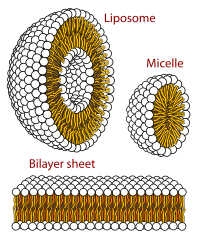Biological membrane: Difference between revisions
Cleanup |
No edit summary Tag: repeating characters |
||
| Line 2: | Line 2: | ||
[[File:Phospholipids aqueous solution structures.svg|thumb|200px|right|Cross section view of the structures that can be formed by phospholipids in aqueous solutions]] |
[[File:Phospholipids aqueous solution structures.svg|thumb|200px|right|Cross section view of the structures that can be formed by phospholipids in aqueous solutions]] |
||
A '''biological membrane''' or '''biomembrane''' |
A '''biological membrane''' or '''biomembrane''' TIMYYYYYYYYYYYYYYYis an enclosing or separating |
||
[[Membrane (selective barrier)|membrane]] that acts as a selective barrier, within or around a [[cell (biology)|cell]]. It consists of a [[lipid bilayer]] with embedded [[integral membrane protein|proteins]] that may constitute close to 50% of membrane content.<ref>{{cite book| author = Mark L. Latash| title = Neurophysiological basis of movement| year = 2007| publisher = Human Kinetics Publishers| isbn = 978-0-7360-6367-8 }}</ref> The cellular membranes should not be confused with isolating [[Tissue (biology)|tissues]] formed by layers of cells, such as [[mucous membrane|mucous]] and [[Basement membrane|basement]] membranes. |
[[Membrane (selective barrier)|membrane]] that acts as a selective barrier, within or around a [[cell (biology)|cell]]. It consists of a [[lipid bilayer]] with embedded [[integral membrane protein|proteins]] that may constitute close to 50% of membrane content.<ref>{{cite book| author = Mark L. Latash| title = Neurophysiological basis of movement| year = 2007| publisher = Human Kinetics Publishers| isbn = 978-0-7360-6367-8 }}</ref> The cellular membranes should not be confused with isolating [[Tissue (biology)|tissues]] formed by layers of cells, such as [[mucous membrane|mucous]] and [[Basement membrane|basement]] membranes. |
||
Revision as of 14:11, 23 September 2011

A biological membrane or biomembrane TIMYYYYYYYYYYYYYYYis an enclosing or separating membrane that acts as a selective barrier, within or around a cell. It consists of a lipid bilayer with embedded proteins that may constitute close to 50% of membrane content.[1] The cellular membranes should not be confused with isolating tissues formed by layers of cells, such as mucous and basement membranes.
Function
Membranes in cells typically define enclosed spaces or compartments in which cells may maintain a chemical or biochemical environment that differs from the outside. For example, the membrane around peroxisomes shields the rest of the cell from peroxides, and the cell membrane separates a cell from its surrounding medium. Most organelles are defined by such membranes, and are called "membrane-bound" organelles.
Probably the most important feature of a biomembrane is that it is a selectively permeable structure. This means that the size, charge, and other chemical properties of the atoms and molecules attempting to cross it will determine whether they succeed in doing so. Selective permeability is essential for effective separation of a cell or organelle from its surroundings. Biological membranes also have certain mechanical or elastic properties.
Particles that are required for cellular function but are unable to diffuse freely across a membrane enter through a membrane transport protein or are taken in by means of endocytosis.
Diversity of biological membranes
Many types of specialized plasma membranes can separate cell from external environment: apical, basolateral, presynaptic and postsynaptic ones, membranes of flagella, cilia, microvillus, filopodia and lamellipodia, the sarcolemma of muscle cells, as well as specialized myelin and dendritic spine membranes of neurons. Plasma membranes can also form different types of "supramembrane" structures such as caveola, postsynaptic density, podosome, invadopodium, desmosome, hemidesmosome, focal adhesion, and cell junctions. These types of membranes differ in lipid and protein composition.
Distinct types of membranes also create intracellular organelles: endosome; smooth and rough endoplasmic reticulum; sarcoplasmic reticulum; Golgi apparatus; lysosome; mitochondrion (inner and outer membranes); nucleus (inner and outer membranes); peroxisome; vacuole; cytoplasmic granules; cell vesicles (phagosome, autophagosome, clathrin-coated vesicles, COPI-coated and COPII-coated vesicles) and secretory vesicles (including synaptosome, acrosomes, melanosomes, and chromaffin granules).
Different types of biological membranes have diverse lipid and protein compositions. The content of membranes defines their physical and biological properties. Some components of membranes play a key role in medicine, such as the efflux pumps that pump drugs out of a cell.
See also
- Bladder (disambiguation)
- S-layer
- Membrane lipids
- Biofilm
- Membrane protein
- Osmosis
- Mucous membrane
- Fetal membranes of amnion and chorion[2]
- Basement membrane
- Serous membrane
- Tympanic membrane
References
- ^ Mark L. Latash (2007). Neurophysiological basis of movement. Human Kinetics Publishers. ISBN 978-0-7360-6367-8.
- ^ UpToDate Patient Preview > Fetal membranes: Anatomy and biochemistry Author: Seth Guller, PhD. Retrieved on Mars 7, 2010
3. Heijne, Gunnar Von, and Douglas Rees. "Membranes: Reading Between the Lines." Current Opinion in Structural Biology 18 (2008): 403-05. Elsevier. 12 Aug. 2008. Web. 21 Nov. 2010. <http://www.sciencedirect.com/science?_ob=MImg&_imagekey=B6VS6-4T6G5B4-1-1&_cdi=6254&_user=4429&_pii=S0959440X08000912&_origin=search&_coverDate=08%2F31%2F2008&_sk=999819995&view=c&wchp=dGLbVlb-zSkzk&md5=b8180fdc23846ea6e37b83150779d102&ie=/sdarticle.pdf>.
External links
- Membranes at the U.S. National Library of Medicine Medical Subject Headings (MeSH)
